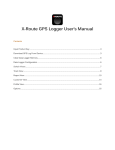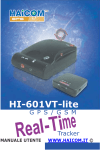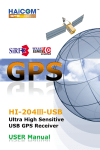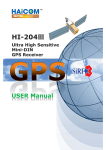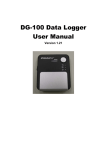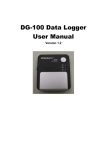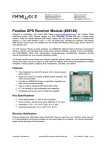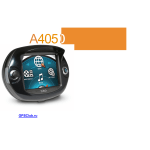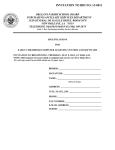Download HI-601VT
Transcript
HI-601VT G P S / G S M Real-Time Tracker USER MANUAL 1 HI-601VT 1 HI-601VT GPS/GSM Tracker INTRODUCTIONS: With HI-601VT GPS/GSM tracker, one can track, remote control, tapping any object globally in real time by using any regular SIM card (with one phone number), any regular phone (home phone, mobile phone, smart phone, etc.) and any local mapping software or Google Earth. No any special software needed. Because HI-601VT is small in size and main unit come with the big capacity rechargeable battery, it is also very suitable for personal tracking. On the HI-601VT, one can press the “panic button” and HI-601VT will instantly dial back to the preset telephone numbers (can set three numbers in different priority). With the optional car kit accessories, car control cables, microphone, moving sensor, one can remotely control certain functions: Car control cable sets: To stop the car oil and electricity from any phone. Micro-phone sets: to hear the voice from HI-601VT side. Vibration sensor: HI-601VT will automatically dial back when the moving occur. 1 2 HOW HI-601VT works: Unlike most GPS/GSM tracker using the GPRS communication in SMS message in none-real time mode and require control station (require monthly fee) or Internet access, HI-601VT no need any control center and special software. Since it is point to point solution, it is also no need to check the object from the Internet. wherever one can make the phone call, one can track the object and see the moving from any mapping software in real time. 2 HI-601VT 3 Just like you call someone and he tells you where the object is and shows you where he is on the mapping software. HI-601VT provide non-stop and continue real time tracking without time limitation. Just like you talk to someone over the phone as long as you can. 3 4 Step by Step operation explanations: 1. Switch power on HI-601VT main unit. 2. The GPS receiver module in HI-601VT start receive GPS satellite signal (The GPS LED blinking means the GPS is in 3D fixed and the data is valid) 3. The GSM module starts sending the GPS data via GSM network back to the host side (The GSM LED blinking means the GSM network stand by and stay on means the GSM connected with some host) 4. Dial the Telephone number from the host side to the HI601VT main unit. 4 HI-601VT 5 5. Switch on HI-601VT decoder (Switch on the middle for data out via wired connection and to the most right side for wireless Bluetooth connection) 6. Connect the voice jack cable to the voice outlet from the phone. 7. The HI-601VT A/D decoder start to decoding the Analog GPS voice message into real-time GPS digital NMEA message. 8. On the decoder unit, connect the PS/II output cable or set up Bluetooh connection to the display unit (such as smart phone, PDA, laptopPC, desktopPC, etc.) 9. Using any standard NMEA mapping software, select the com port, start GPS (just like using normal GPS receiver) 5 HI-601VT main unit 6 overview Alarm release SOS panic button Connector for data control output and power in Mini1394 connector GPS status LED for GPS data output and power in GPS MMCX external GSM status LED antenna plug Power status LED Power ON/OFF 6 HI-601VT 7 Getting Start Open battery cabinet cover 1 3 Insert SIM card 2 4 Put battery in Close battery cabinet cover 5 7 8 GSM LED indicator Status GSM Stand-by Searching network or no SIM card Network connected LED Off 3 sec. and on 75 micro Sec. On 600 micro sec. and off 600 micro sec. Stay on Power LED indicator Status Battery low External powered (Power full) External powered - charging GPS LED indicator Status Searching GPS GPS 3D fixed LED (Color) Red Green Orange LED Stay on Blinking HI-601VT set contains two main units: 1. HI-601VT unit installed on the “client side”: in your car, someones' back pack, etc. 2. Decoder unit carried with the “host side” Inside HI-601VT contain five main parts: 1) SiRF StarIII high sensitive GPS receiver module, 2) Tri-band GSM module, 3) System control circuit section, 4) Power management section, 5) Rechargeable battery Decoder unit contain three parts: 1) A/D converter circuit section, 2) Bluetooth module, 3) Two 3A batteries 8 HI-601VT 9 Inside HI-601VT, the GPS module receive satellite signal and transfer the data into standard NMEA protocol data. Then, the GSM module transmit the data in analog voice message via regular communication network (just like calling and talk from one phone to another phone). As soon as these two devices communicated, HI-601VT will keep transmitting the “voice” to the user side. By connecting the voice phone jack cable from the users' phone to the decoder unit (the purpose of the decoder unit is to transfer the analog voice message into the digital NMEA standard sentences), the wireless Bluetooth module inside will start sending the NMEA message to the display devices, such as, PDA, laptopPC, desktopPC, etc. after the Bluetooth connection was set up. Track with different occasions: 1. With Smartphone: If user has the smartphone (PDA with Bluetooth feature and phone function), by connecting the decoder from the voice jack, one can communicate to the HI-601VT with the smartphone and perform the tracking on the same smartphone. 2. With PDA and mobile or home phone: The phone set up communication to HI-601VT. Connect the voice jack cable between the phone speaker phone jack and the decoder. The decoder sends the NMEA sentence back to the PDA via the Bluetooth connection. 3. With laptopPC and mobile or home phone: The phone set up communication to HI-601VT. Connect the cable between the phone speaker phone jack and the decoder. The decoder sends the NMEA sentence back to the laptopPC via the Bluetooth connection or by the cable sets. 9 10 HOW to USE Option#1 4 3 1 2 1. Decoder with smart (PDA) phone: 1. The smart (PDA) phone calling or communicate with the HI-601VT 2. Voice message to the decoder 3. Voice message was transferred into standard digital NMEA protocol data 4. The NMEA data was transmitted back to the smart (PDA) phone via Bluetooth® connection wirelessly 10 HI-601VT 11 HOW to USE Option#2 3 1 PDA cable 2 4 1. Decoder with smart (PDA) phone: 1. The smart (PDA) phone calling or communicate with the HI-601VT 2. Voice message to the decoder 3. Voice message was transferred into standard digital NMEA protocol data 4. The NMEA data was transmitted back to the smart (PDA) phone via PDA cable 11 12 HOW to USE Option#3 USB port from LaptopPC 3 1 2 4 1. Decoder with smart (PDA) phone and laptopPC (or desktopPC): 1. The smart (PDA) phone calling or communicate with the HI-601VT 2. Voice message to the decoder 3. Voice message was transferred into standard digital NMEA protocol data 4. The NMEA data was transmitted to the laptopPC via USB cable 12 HI-601VT 13 HOW to USE Option#4 Mobile Phone 3 1 4 2 1. Decoder with mobile phone and laptopPC (or desktopPC): 1. The mobile phone calling or communicate with the HI-601VT 2. Voice message to the decoder 3. Voice message was transferred into standard digital NMEA protocol data 4. The NMEA data was transmitted to the laptopPC via USB cable 13 14 HOW to USE Option#5 4 Bluetooth® dongle 3 1 2 1. Decoder with mobile phone and laptopPC (or desktopPC): 1. The mobile phone calling or communicate with the HI-601VT 2. Voice message to the decoder 3. Voice message was transferred into standard digital NMEA protocol data 4. The GPS NMEA data was transmitted to the laptopPC via Bluetooth® wirelessly 14 HI-601VT 15 4. With smartphone or mobile phone and track with SMS in none-real time bases (without decoder): The phone set up communication to HI-601VT. Press “71” and hang up the phone. In few seconds, the phone will receive a short message indicating the HI-601VT current coordinates. Then, go to Google Earth or any mapping software (in none navigation mode) and key in the coordinates. The map will point out the exact location. (1) Dial the number to HI-601VT (2) After connection, press “71”. then, hang up. (1) (2) In few seconds, your mobile will receive a SMS message reqarding to the current location coordinate. 15 16 Key in the coordinates into the Google Earth or any mapping software for the location 16 Key in latitude and longitude data received from SMS HI-601VT 17 Use HI-601VT unit as a regular GPS receiver: By connecting different kinds of optional accessory cables from the side of HI-601VT mini1394 connector, the HI-601VT can also be all kind regular GPS receivers. For instance, HI-601VT can connect a HI-403BT cube and the combination can be a regular Bluetooth GPS receiver for car navigation. Or, connect an optional USB cable to become a USB GPS receiver for laptopPC navigation. Use HI-601VT as a regular Bluetooth GPS receiver (with HI-403BT box and cigarette lighter) 17 18 HI-601VT as a regular wired GPS mouse: By connection different optional connecting cables, HI-601VT can be all kinds of independent wired GPS receiver solutions. 18 HI-601VT 19 ACCESSORIES: Standard Accessories: 1. HI-601VT unit 1 2. Decoder unit 3. Voice jack/PSII to mini-1394 Y cable 4. Mini-1394 to USB power cable 5. AC power adaptor with USB plug 6. Cigarette lighter adaptor with USB plug 7. 1600 mAh Li-on rechargeable battery 8. Carrying pouch 9. Mini CD 10.User manual 5 7 6 8 9 19 10 2 3 4 20 To HI-601VT Power LED Optional Accessories: 1. Car control kits main unit 2. Car control cable sets Tapping MIC 3. Micro-phone cable set 4. Vibration sensor cable set 5. HI-601VT to car kit cable 6. HI-403BTcube DC 12V~24V (Cigarette Lighter) 7. Mini-1394 to PS/II (male) cable 1 To 403BT DC 12V~2 4V 1— GND 2— Vin 12~24V 3 Vibration 4 sensor reset 5 help sw 6 panic button 7x 8— Burglar trigger 9 10 Remote Relay 2 11 12 Remote Relay 2 > > To Vibration Sensor 2 > > 3 7 4 6 5 20 HI-601VT 21 Operation Easy Manual No pass code required mode Press “5” to enter the emergency status Press “8” to activate the bugging under none encryption mode saving mode activated) Press “ * ” to stop sending voice message back and hear “du du” responding Press “ 0 0 0 0 ” (per-setted) and hear a long “du” verifying the pass code confirmed. Change the pass code by pressing “ 0 1234 1234 ” (example) pass code correct: a long “du” and pass code incorrect: du 4 times “du du du du” Set the first set dial-back telephone number: “ 1 0912 345678*” Setup correct: a long “du” and incorrect: du 4 times “du du du du” (anti-thief alarm) Set the second set dial-back telephone number: “ 2 0912 345678* “ Setup correct: a long “du” and incorrect: du 4 times “du du du du” (anti-thief alarm) Set the third set dial-back telephone number: “ 3 0912 345678* ” Setup correct: a long “du” and incorrect: du 4 times “du du du du” (anti-thief alarm) Remove first set dial-back telephone number: “ 1 * ” Remove correct: a long “du” and incorrect: du 4 times “du du du du” Remove second set dial-back telephone number: “ 2 * ” Remove correct: a long “du” and incorrect: du 4 times “du du du du” Remove third set dial-back telephone number: “ 3 * ” Remove correct: a long “du” and incorrect: du 4 times “du du du du” SOS dial-back: 4, 5, 6 three sets Press “ # ” to stop sending voice message back and hear “du du” responding Press “ 0 0 0 0 ” (per-setted) and hear a long “ du” verifying the pass code confirmed. Change the PIN code by pressing “ 0 5678 5678 ” (example) PIN code correct: a long “du” and Cancel PIN code by pressing “ 0 # ” and a long “du” confirm it is correct Press “ 1 ” for temporary disable tracking encryption mode under tracking encryption mode. 21 22 Send back data 50 times (around 3 minites ) when the set up correct. Short message send back to the preset dial-back number by pressing “ 21 ” “ 22 ” “ 23 ” Connection hanged up when set up correctly. Press “ 2# ” to disable short message function Press “ 2* ” to enable short message function (pre-setted) Set up correct: a long “du” and incorrect: du 4 times “du du du du” Press “ 40 ” to immediately cut off oil and electricity Set up correct: a long “du” and incorrect: du 4 times “du du du du” Press “ 51 ” to disable moving sensor function (pre-setted) Press “ 52 ” to enable moving sensor function Set up correct: a long “du” and incorrect: du 4 times “du du du du” (Anti-thief mode can also works normally) Press “ 54 ” to bugging without the pass code mode (pre-setted) Press “ 55 ” to bugging with pass code required mode Set up correct: a long “du” and incorrect: du 4 times “ du du du du” Press “ 57 ” to tracking with no encryption required (pre-setted) Press “ 58 ” to tracking with encryption mode (under encryption mode, the voice message is steady tune and unable to decode it) Set up correct: a long “du” and incorrect: du 4 times “du du du du” Press “ 53 ” for moving sensor trigger and instant dial back (pre-setted) Press “ 56 ” for moving sensor trigger and delay dial back Set up correct: a long “du” and incorrect: du 4 times “du du du du” Press “ 6* ” for GPS location dial back on certain times Connection hanged up when set up correctly. Press “ 6# ” for GPS location speed mode than 20 km Connection hanged up when set up correctly. 22 HI-601VT 23 Press “ 62 ” for automatically enable dial back when GPS location speed mode than 20 km under moving sensor activated mode. Press “ 61 ” for manually enable dial back when GPS location speed mode than 20 km under moving sensor activated mode (pre-setted) PS: (under the activate moving sensor trigger mode 52) Dial back testing, press “ 71 ” dial back the 1, 2, 3 sets numbers. Press “ 8 ” for in car bugging Under none encryption protection mode, press “ 8 ” directly without press the pass code. Press “ 9 ” from leaving mode back to tracking mode or not pressing any keys in 10 seconds to enable from leaving mode back to tracking mode. After anti-thief dial back mode, take the call and dial “ * * * ” to disable the dial back NOTE: Please press at 2 seconds intervals in each button SMS Example: SMS Short message ALARM = Anti-thief trigger dial back SENSOR = moving sensor trigger dial back SOS = ask for help dial back *V, N, 23” 51' 15.6, E, 120” 38' 09.6, 020. 3, 359. 9* V = GPS last location A = GPS current location N, 23” 51' 15.6 = North 23” 51' 15.6 E, 120” 38' 09.6 = East 120” 38' 09.6 020.3 = Speed (sea mile) 359.9 = Direction 23 24 Dimension: 60mm 29.5mm 84mm 60mm 24 HI-601VT 25 GPS Receiver Specifications Chipset SiRF Star III Protocol NMEA0183 GGA, GSA, GSV, RMC, GLL Baud Rate 4800, N, 8, 1 Max. Update Rate 1 Hz Datum WGS84 Channel 20 channel Frequency L1, 1575.42MHz Hot Start 8 sec. Average Warm Start 38 sec. Average Cold Start 48 sec. Average Reacquisition Tike 100 ms Position Accuracy 15m 2D RMS, SA off Macimum Altitude 18,000m Maximum velocity 515m/s Voltage DC 3.3V+-10% Power consumption 90mA continuous mode Antenna Type Built-in active antenna External Antenna MMCX (Optional) Connector Dimension 84 (L) x 60 (W) x 29.5 (H)mm LED Indicator 3D Positioning (blinking) or Searching GPS (on) 25 26 GSM module features Feature Power saving Charging Frequency bands Implementation Minimizes power consumption in SLEEP mode to 3mA Supports charging control for Li-lon battery • MC55 Tri-band: EGSM 900, GSM 1800, GSM 1900 • Compliant to GSM Phase 2/2+ GSM Class Small MS Transmit power • Class 4 (2W) at EGSM900 and GSM850 • Class 1 (1W) at GSM1800 and GSM1900 GPRS Connectivity • GPRS multi-slot class 10 • GPRS mobile station class B Temperature range • Normal operation: -20° C to +55° C • Restricted operation:-25° C to -20° C & +55° C to +70° C Temperature control • Constant temperature control prevents damage to and auto switch-off MC55/56 when the specified temperature is exceeded. When an emergency call is in progress the automatic temperature shutdown functionality is deactivated. DATA GPRS: • GPRS data downlink transfer: max. 85.6 kbps • GPRS data uplink transfer: max. 42.8 kbps • Coding scheme: CS-1, CS-2, CS-3 and CS-4 • Supports the two protocols PAP (Password Authentication Protocol) and CHAP (Challenge Handshake Authentication Protocol) commonly used for PPP connections. • Support of Packet Switched Broadcast Control Channel (PBCCH) allows you to benefit from enhanced GPRS performance when offered by the network operators. CSD: • CSD transmission rates: 2.4, 4.8, 9.6, 14.4 kbps, non-transparent, V.110 • Unstructured Supplementary services Data (USSD) support WAP: • WAP compliant SMS • MT, MO, CB, Text and PDU mode • SMS storage: SIM card plus 25 SMS locations in the mobile equipment • Transmission of SMS alternatively over CSD or GPRS. Preferred mode can be user-defined. MMS MMS compliant 26 HI-601VT 27 Feature SIM interface Implementation • Supported SIM card: 3V • External SIM card reader has to be connected via interface connector Audio interfaces Two analog audio interfaces, one digital audio interface(DAI) Audio features Speech code modes: • Half Rate (ETS 06.20) • Full Rate (ETS 06.10) • Enhanced Full Rate (ETS 06.50 / 06.60 / 06.80) • Adaptive Multi Rate (AMR) Handsfree operation • Echo cancellation • Noise reduction Two serial interfaces: • 2.65V level, bi-directional bus for AT commands and ASC0,ASC1 data • ASC0 - full- featured 8-wire serial interface. Supports RTS0/CTS0 hardware handshake and software XON/XOFF flow control. Multiplex ability according to GSM 07.10 Multiplexer Protocol. • ASC1 - 4-wire serial interface. Supports RTS1/CTS1 hardware handshake and software XON/XOFF flow control. • Baud rate: 300bps… 230kbps on ASC0 and ASC1 • Autobauding (on ASC0 only) detects 1200, 2400, 4800, 9600, 19200, 38400, 57600, 115200, 230400 bps SIM Application SIM Application Toolkit Supports SAT class3, GSM 11.14 Toolkit Release 98, support of letter class ”c” Ringing tones Offers a choice of 7 different ringing tones / melodies, easily selectable with AT command Real time clock Implemented Timer function Programmable via AT command Support of TTY/CTM To benefit from TTY communication via GSM, CTM equipment can be connected to one of the three audio interfaces. Firmware upgrade Firmware upgradable over serial interface and SIM interface 27 28 HI-601VT Decoder How to Use: A. Connect the inclusive phone jack/PSII to mini1394 Y cable to the decoder: Mini1394 connector to the side of the decoder, phone jack to the phone jack outlet) B. As soon as turn on the power switch, the red LED light start blinking once per second. The updated coordinates will be sent out from “mini-1394 output” and “Bluetooth output” each second. PS. The data format is 4800, 8, N, 1 and computer will take the RS232 data from COM 1, COM2 or other com port. C. Start mapping software and activate the GPS signal receiving. The most update location (or the last location) will be shown on the mapping software. D. The orange LED light (GPS in 3D fixed) followed by the red light meaning the data is valid and is the real time location coordinate. The status also means that the car or the person should be in outdoor and the GPS receiver able to gets and lock more than 4 satellites. If the yellow light not lighted meaning the GPS data is not the real time coordinate (could be the old location coordinate) The status also means that the car or the person should be indoor and the GPS receiver unable to gets and lock more than 4 satellites. 28 HI-601VT 29 Decoder LED indicator Symbol LED Color Orange Bluetooth Red Green Stay on Blinking GPS data valid (3D fixed) GPS data not valid Bluetooth Connected Bluetooth no connected Decoding (4 seconds interval) Receiving data 29

































